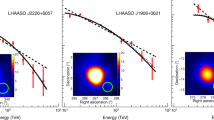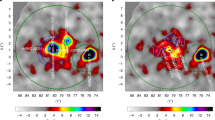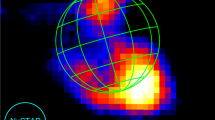Abstract
IN recent years there have been many attempts to detect extraterrestrial gamma radiation of energy greater than 50 MeV (refs. 1–14), but the only positive evidence of the presence of this radiation was obtained recently by the OSO III satellite experiment of Clark et al.15. Their measurements reveal a significant flux of gamma-rays, associated with the galactic plane and an enhancement in the direction of the galactic centre. At present it is not-known whether this flux comes from a number of unresolved point sources, collisions between cosmic-ray protons and interstellar hydrogen, or Compton collisions between cosmic-ray electrons and the high intensity infrared radiation background16,17. Attempts to detect the radiation by balloon experiments have suffered from a high level of locally generated background, which made the identification of the weak galactic source of gamma-rays a difficult task. So far all balloon experiments have had an extrapolated primary flux at the top of the atmosphere greater than 1 × 10−3 photons cm−2 s−1 sr−1, irrespective of the type of detectors used (usually nuclear emulsions, scintillation Cerenkov detectors and spark chambers). This flux is an order of magnitude higher than the value of the isotropic primary flux of (1.2 ± 0.2) × 10−4 photons cm−2 s−1 sr−1 reported by the OSO III experiment.
This is a preview of subscription content, access via your institution
Access options
Subscribe to this journal
Receive 51 print issues and online access
$199.00 per year
only $3.90 per issue
Buy this article
- Purchase on Springer Link
- Instant access to full article PDF
Prices may be subject to local taxes which are calculated during checkout
Similar content being viewed by others
References
Braccesi, A., Ceccarelli, M., and Salandin, G., Nuovo Cimento, 17, 691 (1960).
Cline, T. L., Phys. Rev. Lett., 7, 109 (1961).
Klarmann, J., Nuovo Cimento, 24, 540 (1962).
Duthie, J. G., Hafner, E. M., Kaplon, M. F., and Fazio, G. G., Phys. Rev. Lett., 10, 364 (1963).
Cobb, R., Duthie, J. G., and Stewart, J., Phys. Rev. Lett., 15, 507 (1965).
Fichtel, C. E., and Kniffen, D. A., J. Geophys. Res., 70, 4227 (1965).
Duthie, J. G., Cobb, R., and Stewart, J., Phys. Rev. Lett., 17, 263 (1966).
Frye, G. M., and Smith, L. H., Phys. Rev. Lett., 17, 733 (1966).
Frye, G. M., Reines, F., and Armstrong, A. H., J. Geophys. Res., 71, 3119 (1966).
Fazio, G. G., and Hafner, E. M., J. Geophys. Res., 72, 2452 (1967).
Frye, G. M., and Wang, C. P., Phys. Rev. Lett., 18, 132 (1967).
Delvaille, J. P., Albats, P., Greisen, K. I., and Ogelman, H. B., Canad. J. Phys., 46, 425 (1968).
Fichtel, C. E., Cline, T. L., Ehrmann, C. H., Kniffen, D. A., and Ross, R. W., Canad. J. Phys., 46, 419 (1968).
Kraushaar, W., Clark, G. W., Garmire, G., Holmken, H., Higbie, B., and Agogino, M., Astrophys. J., 141, 845 (1965).
Clark, G. W., Garmire, G. P., and Kraushaar, W. L., Astrophys. J., 153, L203 (1968).
Cowsik, R., and Pal, Yash, Phys. Rev. Lett., 22, 550 (1969).
Shen, C. S., Phys. Rev. Lett., 22, 568 (1969).
Crawford, D. F., and Messel, H., Phys. Rev., 128, 2352 (1962).
Author information
Authors and Affiliations
Rights and permissions
About this article
Cite this article
SOOD, R. Detection of High Energy Gamma-rays from the Galactic Disk at Balloon Altitudes. Nature 222, 650–652 (1969). https://doi.org/10.1038/222650a0
Received:
Issue Date:
DOI: https://doi.org/10.1038/222650a0
This article is cited by
-
The neutral-pion decay and the gamma radiation from our galaxy
Il Nuovo Cimento B Series 11 (1971)
-
High-energy Gamma-ray Astronomy
Nature (1970)
-
Evidence for a Galactic Component of the Diffuse X-ray Background
Nature (1969)
Comments
By submitting a comment you agree to abide by our Terms and Community Guidelines. If you find something abusive or that does not comply with our terms or guidelines please flag it as inappropriate.



